#AWS IoT Core
Explore tagged Tumblr posts
Text
#Remote IoT APIs#IoT Device Management#Google Cloud IoT Core#AWS IoT#Microsoft Azure IoT#ThingSpeak#Losant IoT#IBM Watson IoT#IoT Solutions 2025
0 notes
Text
How-To IT
Topic: Core areas of IT
1. Hardware
• Computers (Desktops, Laptops, Workstations)
• Servers and Data Centers
• Networking Devices (Routers, Switches, Modems)
• Storage Devices (HDDs, SSDs, NAS)
• Peripheral Devices (Printers, Scanners, Monitors)
2. Software
• Operating Systems (Windows, Linux, macOS)
• Application Software (Office Suites, ERP, CRM)
• Development Software (IDEs, Code Libraries, APIs)
• Middleware (Integration Tools)
• Security Software (Antivirus, Firewalls, SIEM)
3. Networking and Telecommunications
• LAN/WAN Infrastructure
• Wireless Networking (Wi-Fi, 5G)
• VPNs (Virtual Private Networks)
• Communication Systems (VoIP, Email Servers)
• Internet Services
4. Data Management
• Databases (SQL, NoSQL)
• Data Warehousing
• Big Data Technologies (Hadoop, Spark)
• Backup and Recovery Systems
• Data Integration Tools
5. Cybersecurity
• Network Security
• Endpoint Protection
• Identity and Access Management (IAM)
• Threat Detection and Incident Response
• Encryption and Data Privacy
6. Software Development
• Front-End Development (UI/UX Design)
• Back-End Development
• DevOps and CI/CD Pipelines
• Mobile App Development
• Cloud-Native Development
7. Cloud Computing
• Infrastructure as a Service (IaaS)
• Platform as a Service (PaaS)
• Software as a Service (SaaS)
• Serverless Computing
• Cloud Storage and Management
8. IT Support and Services
• Help Desk Support
• IT Service Management (ITSM)
• System Administration
• Hardware and Software Troubleshooting
• End-User Training
9. Artificial Intelligence and Machine Learning
• AI Algorithms and Frameworks
• Natural Language Processing (NLP)
• Computer Vision
• Robotics
• Predictive Analytics
10. Business Intelligence and Analytics
• Reporting Tools (Tableau, Power BI)
• Data Visualization
• Business Analytics Platforms
• Predictive Modeling
11. Internet of Things (IoT)
• IoT Devices and Sensors
• IoT Platforms
• Edge Computing
• Smart Systems (Homes, Cities, Vehicles)
12. Enterprise Systems
• Enterprise Resource Planning (ERP)
• Customer Relationship Management (CRM)
• Human Resource Management Systems (HRMS)
• Supply Chain Management Systems
13. IT Governance and Compliance
• ITIL (Information Technology Infrastructure Library)
• COBIT (Control Objectives for Information Technologies)
• ISO/IEC Standards
• Regulatory Compliance (GDPR, HIPAA, SOX)
14. Emerging Technologies
• Blockchain
• Quantum Computing
• Augmented Reality (AR) and Virtual Reality (VR)
• 3D Printing
• Digital Twins
15. IT Project Management
• Agile, Scrum, and Kanban
• Waterfall Methodology
• Resource Allocation
• Risk Management
16. IT Infrastructure
• Data Centers
• Virtualization (VMware, Hyper-V)
• Disaster Recovery Planning
• Load Balancing
17. IT Education and Certifications
• Vendor Certifications (Microsoft, Cisco, AWS)
• Training and Development Programs
• Online Learning Platforms
18. IT Operations and Monitoring
• Performance Monitoring (APM, Network Monitoring)
• IT Asset Management
• Event and Incident Management
19. Software Testing
• Manual Testing: Human testers evaluate software by executing test cases without using automation tools.
• Automated Testing: Use of testing tools (e.g., Selenium, JUnit) to run automated scripts and check software behavior.
• Functional Testing: Validating that the software performs its intended functions.
• Non-Functional Testing: Assessing non-functional aspects such as performance, usability, and security.
• Unit Testing: Testing individual components or units of code for correctness.
• Integration Testing: Ensuring that different modules or systems work together as expected.
• System Testing: Verifying the complete software system’s behavior against requirements.
• Acceptance Testing: Conducting tests to confirm that the software meets business requirements (including UAT - User Acceptance Testing).
• Regression Testing: Ensuring that new changes or features do not negatively affect existing functionalities.
• Performance Testing: Testing software performance under various conditions (load, stress, scalability).
• Security Testing: Identifying vulnerabilities and assessing the software’s ability to protect data.
• Compatibility Testing: Ensuring the software works on different operating systems, browsers, or devices.
• Continuous Testing: Integrating testing into the development lifecycle to provide quick feedback and minimize bugs.
• Test Automation Frameworks: Tools and structures used to automate testing processes (e.g., TestNG, Appium).
19. VoIP (Voice over IP)
VoIP Protocols & Standards
• SIP (Session Initiation Protocol)
• H.323
• RTP (Real-Time Transport Protocol)
• MGCP (Media Gateway Control Protocol)
VoIP Hardware
• IP Phones (Desk Phones, Mobile Clients)
• VoIP Gateways
• Analog Telephone Adapters (ATAs)
• VoIP Servers
• Network Switches/ Routers for VoIP
VoIP Software
• Softphones (e.g., Zoiper, X-Lite)
• PBX (Private Branch Exchange) Systems
• VoIP Management Software
• Call Center Solutions (e.g., Asterisk, 3CX)
VoIP Network Infrastructure
• Quality of Service (QoS) Configuration
• VPNs (Virtual Private Networks) for VoIP
• VoIP Traffic Shaping & Bandwidth Management
• Firewall and Security Configurations for VoIP
• Network Monitoring & Optimization Tools
VoIP Security
• Encryption (SRTP, TLS)
• Authentication and Authorization
• Firewall & Intrusion Detection Systems
• VoIP Fraud DetectionVoIP Providers
• Hosted VoIP Services (e.g., RingCentral, Vonage)
• SIP Trunking Providers
• PBX Hosting & Managed Services
VoIP Quality and Testing
• Call Quality Monitoring
• Latency, Jitter, and Packet Loss Testing
• VoIP Performance Metrics and Reporting Tools
• User Acceptance Testing (UAT) for VoIP Systems
Integration with Other Systems
• CRM Integration (e.g., Salesforce with VoIP)
• Unified Communications (UC) Solutions
• Contact Center Integration
• Email, Chat, and Video Communication Integration
2 notes
·
View notes
Text
Tamagotchi Uni Uses AWS, Amazon Web Services

The Tamagotchi Uni is the first Tamagotchi to ever connect to Wi-Fi, which enables it to receive over the area updates, programing changes, and more. How exactly is this all being done by Bandai Japan? Well Bandai has built the Tamagotchi Uni on the Amazon Web Services platform (AWS).
The details of this are actually outlined on a recent article on the Amazon Web Services blog. The blog post provided a detailed view on how Tamagotchi Uni use AWS to achieve secure and reliable connectivity and quickly deliver new content updates without leaving customers waiting.It details that Bandai Co., Ltd., the company responsible for product development and sales, adopted AWS IoT to realize the concept of globally interconnected Tamagotchi, enabling users to interact with each other.
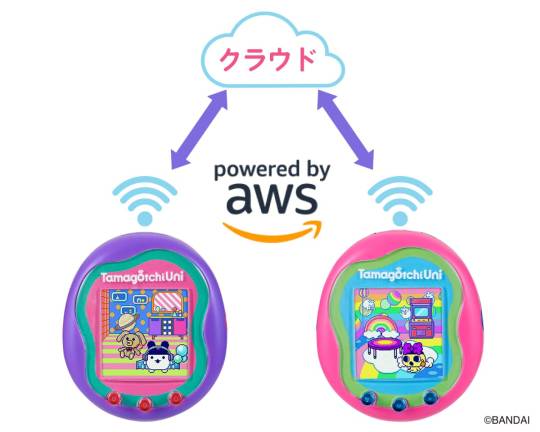
Bandai partnered with their cloud development partner, Phoenisys, Inc., to connect and manage million of Tamagotchi devices. One of the critical features was the over the air software updates which uses the jobs feature of AWS IoT Device Management to distribute the latest firmware across all Tamagotchi devices without causing any delays to customers.
To make Tamagotchi Uni IoT-enabled, Bandai establish the three key goals, which was implementing secure connections, scaling the load-balancing resources to accommodate over 1 million connections worldwide, and optimizing operational costs. The article even features the AWS architecture for the Tamagotchi Uni, which is interesting.
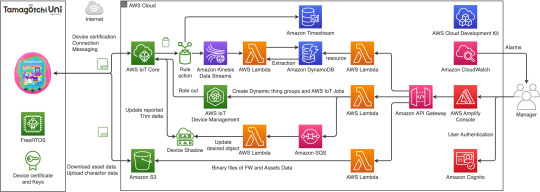
AWS IoT Core is used to manage the state of each Tamagotchi Uni device, which helps retrieve distributed items and content. AWS IoT Device Management is used to index the extensive Tamagotchi Uni fleet and create dynamic groups on the state of each device, facilitating efficient over-the-air (OTA) updates. FreeRTOS is used to minimize the amount of resources and code required to implement device-to-cloud communication for efficient system development. AWS Lambda is used to process tasks, delivering new announcements, and registering assets. Amazon DynamoDB is used as a fully managed, sever less, key-value noSQL database that runs high-performance applications at any scale. Amazon Simple Storage Service (Amazon S3) is used for object storage service, each of these data stores are used to manage the various resources within Tamagotchi Uni. Lastly, Amazon Timestream is used to accumulate historical data of user’s actions like downloading items and additional content.
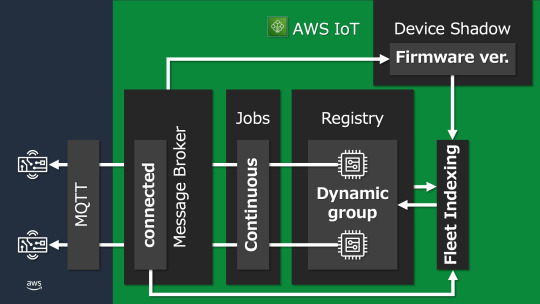
The article also details how Bandai is handling large scale firmware updates to Tamagotchi Uni devices which are executed at a rate of 1,000 units per hour which would have resulted in a delay for some devices. The team actually designed job delivery as a continuous job which automatically updates the devices under certain conditions. This is using fleet indexing that runs a query to see which devices meet the criteria for the update to be pushed out to it.
Lastly the article details how Bandai conducted system performance testing at a large-scale to emulate what it would be like after the device was released. They verified the smooth operation and performance of updates through their testing.
Be sure to check out the full article here on the Amazon AWS blog.
#tamapalace#tamagotchi#tmgc#tamagotchiuni#tamagotchi uni#uni#tamatag#virtualpet#bandai#amazonaws#amazon aws#aws#amazonwebservices#amazon web services#blog
14 notes
·
View notes
Text
From Novice to Pro: Master the Cloud with AWS Training!
In today's rapidly evolving technology landscape, cloud computing has emerged as a game-changer, providing businesses with unparalleled flexibility, scalability, and cost-efficiency. Among the various cloud platforms available, Amazon Web Services (AWS) stands out as a leader, offering a comprehensive suite of services and solutions. Whether you are a fresh graduate eager to kickstart your career or a seasoned professional looking to upskill, AWS training can be the gateway to success in the cloud. This article explores the key components of AWS training, the reasons why it is a compelling choice, the promising placement opportunities it brings, and the numerous benefits it offers.

Key Components of AWS Training
1. Foundational Knowledge: Building a Strong Base
AWS training starts by laying a solid foundation of cloud computing concepts and AWS-specific terminology. It covers essential topics such as virtualization, storage types, networking, and security fundamentals. This groundwork ensures that even individuals with little to no prior knowledge of cloud computing can grasp the intricacies of AWS technology easily.
2. Core Services: Exploring the AWS Portfolio
Once the fundamentals are in place, AWS training delves into the vast array of core services offered by the platform. Participants learn about compute services like Amazon Elastic Compute Cloud (EC2), storage options such as Amazon Simple Storage Service (S3), and database solutions like Amazon Relational Database Service (RDS). Additionally, they gain insights into services that enhance performance, scalability, and security, such as Amazon Virtual Private Cloud (VPC), AWS Identity and Access Management (IAM), and AWS CloudTrail.
3. Specialized Domains: Nurturing Expertise
As participants progress through the training, they have the opportunity to explore advanced and specialized areas within AWS. These can include topics like machine learning, big data analytics, Internet of Things (IoT), serverless computing, and DevOps practices. By delving into these niches, individuals can gain expertise in specific domains and position themselves as sought-after professionals in the industry.

Reasons to Choose AWS Training
1. Industry Dominance: Aligning with the Market Leader
One of the significant reasons to choose AWS training is the platform's unrivaled market dominance. With a staggering market share, AWS is trusted and adopted by businesses across industries worldwide. By acquiring AWS skills, individuals become part of the ecosystem that powers the digital transformation of numerous organizations, enhancing their career prospects significantly.
2. Comprehensive Learning Resources: Abundance of Educational Tools
AWS training offers a wealth of comprehensive learning resources, ranging from extensive documentation, tutorials, and whitepapers to hands-on labs and interactive courses. These resources cater to different learning preferences, enabling individuals to choose their preferred mode of learning and acquire a deep understanding of AWS services and concepts.
3. Recognized Certifications: Validating Expertise
AWS certifications are globally recognized credentials that validate an individual's competence in using AWS services and solutions effectively. By completing AWS training and obtaining certifications like AWS Certified Solutions Architect or AWS Certified Developer, individuals can boost their professional credibility, open doors to new job opportunities, and command higher salaries in the job market.
Placement Opportunities
Upon completing AWS training, individuals can explore a multitude of placement opportunities. The demand for professionals skilled in AWS is soaring, as organizations increasingly migrate their infrastructure to the cloud or adopt hybrid cloud strategies. From startups to multinational corporations, industries spanning finance, healthcare, retail, and more seek talented individuals who can architect, develop, and manage cloud-based solutions using AWS. This robust demand translates into a plethora of rewarding career options and a higher likelihood of finding positions that align with one's interests and aspirations.

In conclusion, mastering the cloud with AWS training at ACTE institute provides individuals with a solid foundation, comprehensive knowledge, and specialized expertise in one of the most dominant cloud platforms available. The reasons to choose AWS training are compelling, ranging from the industry's unparalleled market position to the top ranking state.
9 notes
·
View notes
Text
Navigating the Cloud: Unleashing Amazon Web Services' (AWS) Impact on Digital Transformation
In the ever-evolving realm of technology, cloud computing stands as a transformative force, offering unparalleled flexibility, scalability, and cost-effectiveness. At the forefront of this paradigm shift is Amazon Web Services (AWS), a comprehensive cloud computing platform provided by Amazon.com. For those eager to elevate their proficiency in AWS, specialized training initiatives like AWS Training in Pune offer invaluable insights into maximizing the potential of AWS services.

Exploring AWS: A Catalyst for Digital Transformation
As we traverse the dynamic landscape of cloud computing, AWS emerges as a pivotal player, empowering businesses, individuals, and organizations to fully embrace the capabilities of the cloud. Let's delve into the multifaceted ways in which AWS is reshaping the digital landscape and providing a robust foundation for innovation.
Decoding the Heart of AWS
AWS in a Nutshell: Amazon Web Services serves as a robust cloud computing platform, delivering a diverse range of scalable and cost-effective services. Tailored to meet the needs of individual users and large enterprises alike, AWS acts as a gateway, unlocking the potential of the cloud for various applications.
Core Function of AWS: At its essence, AWS is designed to offer on-demand computing resources over the internet. This revolutionary approach eliminates the need for substantial upfront investments in hardware and infrastructure, providing users with seamless access to a myriad of services.
AWS Toolkit: Key Services Redefined
Empowering Scalable Computing: Through Elastic Compute Cloud (EC2) instances, AWS furnishes virtual servers, enabling users to dynamically scale computing resources based on demand. This adaptability is paramount for handling fluctuating workloads without the constraints of physical hardware.
Versatile Storage Solutions: AWS presents a spectrum of storage options, such as Amazon Simple Storage Service (S3) for object storage, Amazon Elastic Block Store (EBS) for block storage, and Amazon Glacier for long-term archival. These services deliver robust and scalable solutions to address diverse data storage needs.
Streamlining Database Services: Managed database services like Amazon Relational Database Service (RDS) and Amazon DynamoDB (NoSQL database) streamline efficient data storage and retrieval. AWS simplifies the intricacies of database management, ensuring both reliability and performance.
AI and Machine Learning Prowess: AWS empowers users with machine learning services, exemplified by Amazon SageMaker. This facilitates the seamless development, training, and deployment of machine learning models, opening new avenues for businesses integrating artificial intelligence into their applications. To master AWS intricacies, individuals can leverage the Best AWS Online Training for comprehensive insights.
In-Depth Analytics: Amazon Redshift and Amazon Athena play pivotal roles in analyzing vast datasets and extracting valuable insights. These services empower businesses to make informed, data-driven decisions, fostering innovation and sustainable growth.

Networking and Content Delivery Excellence: AWS services, such as Amazon Virtual Private Cloud (VPC) for network isolation and Amazon CloudFront for content delivery, ensure low-latency access to resources. These features enhance the overall user experience in the digital realm.
Commitment to Security and Compliance: With an unwavering emphasis on security, AWS provides a comprehensive suite of services and features to fortify the protection of applications and data. Furthermore, AWS aligns with various industry standards and certifications, instilling confidence in users regarding data protection.
Championing the Internet of Things (IoT): AWS IoT services empower users to seamlessly connect and manage IoT devices, collect and analyze data, and implement IoT applications. This aligns seamlessly with the burgeoning trend of interconnected devices and the escalating importance of IoT across various industries.
Closing Thoughts: AWS, the Catalyst for Transformation
In conclusion, Amazon Web Services stands as a pioneering force, reshaping how businesses and individuals harness the power of the cloud. By providing a dynamic, scalable, and cost-effective infrastructure, AWS empowers users to redirect their focus towards innovation, unburdened by the complexities of managing hardware and infrastructure. As technology advances, AWS remains a stalwart, propelling diverse industries into a future brimming with endless possibilities. The journey into the cloud with AWS signifies more than just migration; it's a profound transformation, unlocking novel potentials and propelling organizations toward an era of perpetual innovation.
2 notes
·
View notes
Text
Big Data Made Simple: Tools, Trends, and Technologies
Big Data Made Simple: Tools, Trends, and Technologies
In the modern era, the term "Big Data" has transcended the realm of tech jargon to become a cornerstone of contemporary business strategy. But what exactly is Big Data, and why is it so crucial? This blog will unravel the mysteries of Big Data by exploring its core components, real-world applications, and the tools and professionals that bring data to life.
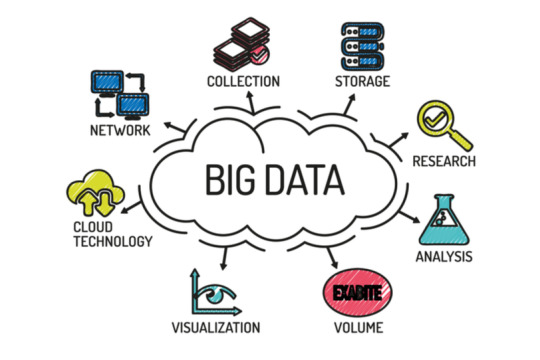
Big Data Analysis
What is Big Data?
To understand Big Data, we must first appreciate its defining characteristics, commonly referred to as the 5Vs: Volume, Velocity, Variety, Veracity, and Value.
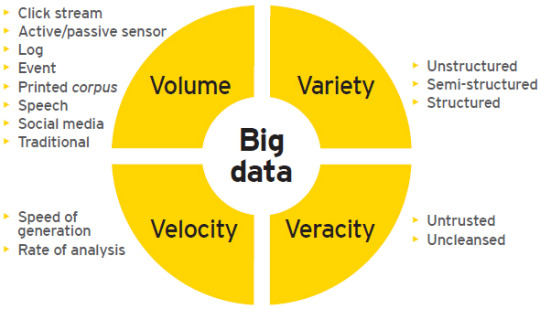
Big data Characteristics
Volume: Big Data is characterized by vast quantities of data, from terabytes to petabytes and beyond. The sheer scale of data generated daily is staggering.
Velocity: The speed at which data is generated, processed, and analyzed is crucial. In many industries, real-time data processing is necessary for making timely decisions.
Variety: Data comes in all shapes and sizes. From structured data in databases to unstructured data like social media posts and videos, Big Data encompasses a wide array of data types.
Veracity: Ensuring the accuracy and trustworthiness of data is critical. High veracity ensures that insights drawn from data are reliable and actionable.
Value: Ultimately, the purpose of Big Data is to derive value. By analyzing Big Data, businesses can gain insights that lead to improved decision-making and strategic advantages.
Structured vs Unstructured Data
Data can be broadly categorized into two types: structured and unstructured.
Structured Data: This refers to data that is organized into a defined format, such as rows and columns in a database. It is easily searchable and often stored in data warehouses.
Unstructured Data: This type of data lacks a pre-defined structure. Examples include emails, videos, social media posts, and sensor data. While more challenging to analyze, unstructured data often holds valuable insights.

Types of Data format
Real-world Use Cases
Big Data is transforming industries across the globe. Here are a few notable examples:
Healthcare: In healthcare, Big Data is used for predicting epidemics, improving patient care, and enhancing the accuracy of diagnoses. Large datasets enable personalized medicine and efficient resource management.
Finance: Financial institutions leverage Big Data for fraud detection, risk management, and personalized banking services. By analyzing transaction patterns, banks can offer tailored solutions to customers.
Retail: Retailers use Big Data to optimize inventory management, enhance customer experience, and drive marketing strategies. Understanding consumer behavior through data analysis can lead to increased sales.
IoT (Internet of Things): With the proliferation of connected devices, IoT generates massive amounts of data. Analyzing this data can improve operational efficiency, predictive maintenance, and smart city management.
Overview of Analysis Tools
Several tools and platforms are essential for Big Data analysis:
SQL Server: A relational database management system that handles structured data and provides robust querying capabilities.
Hive: A data warehouse infrastructure built on top of Hadoop, enabling easy data summarization and analysis.
BigQuery: A serverless, highly scalable data warehouse offered by Google Cloud, known for its speed and SQL-like interface.
SparkSQL: Part of the Apache Spark ecosystem, SparkSQL allows for querying structured data with fast, in-memory processing.
Cloud Platforms: Cloud services like AWS, Azure, and Google Cloud provide scalable infrastructure and tools for Big Data storage, processing, and analysis.
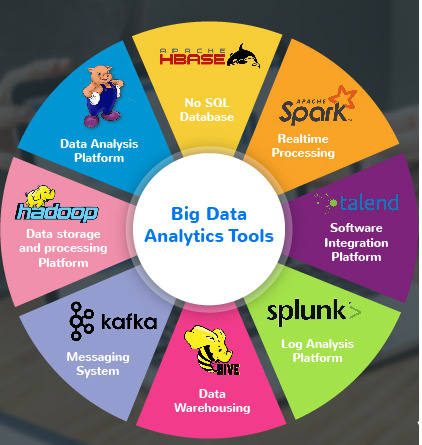
Big data Analysis Tools
The Role of Data Engineers & Analysts
Data engineers and analysts play pivotal roles in the Big Data ecosystem:
Data Engineers: They are responsible for designing, building, and maintaining the architecture that allows data to be ingested, processed, and stored. Their work ensures that data is accessible and reliable for analysis.
Data Analysts: Analysts transform raw data into meaningful insights. They use statistical techniques and tools to interpret data, identify trends, and provide actionable recommendations for business growth.

Role of Data Analysis
FAQs
1. What are the main challenges of working with Big Data? Managing the volume, ensuring data quality, and integrating diverse data types are some of the major challenges in Big Data.
2. How does Big Data differ from traditional data? Big Data involves large volumes, high velocity, and diverse formats, while traditional data is usually smaller, slower, and more uniform in structure.
3. What skills are essential for a career in Big Data? Key skills include proficiency in data analysis tools, programming languages like Python or R, and a strong understanding of data management and architecture.
4. Can small businesses benefit from Big Data? Absolutely. Big Data can help small businesses understand customer behavior, improve marketing strategies, and optimize operations.
5. How is Big Data impacting privacy? With the increase in data collection, privacy concerns are rising. It's important for companies to comply with regulations and ensure data protection practices are in place.
By demystifying Big Data, businesses can harness its potential to drive innovation and maintain a competitive edge in today’s data-driven world.
Home
instagram
youtube
#BigData#DataAnalytics#DataScience#CloudComputing#DataEngineering#BigDataTools#TechEducation#DataDriven#SunshineDigitalServices#DigitalInnovation#Instagram#Youtube
0 notes
Text
AWS Cloud Services: A Critical Enabler in the Healthcare Industry
The healthcare industry has undergone a digital transformation, driven by the need for agility, patient-centric services, and operational efficiency. Central to this evolution is the growing reliance on AWS cloud services. With its suite of AWS-managed services and scalable infrastructure, Amazon Web Services (AWS) is helping healthcare organizations overcome traditional IT limitations while ensuring compliance, data security, and innovation.
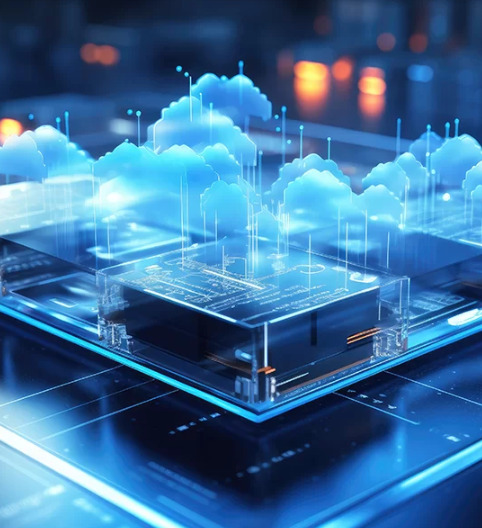
The Shift Toward Cloud in Healthcare
Healthcare providers, payers, and life sciences organizations are turning to cloud computing to modernize their systems, manage electronic health records (EHRs), and unlock the value of big data and artificial intelligence (AI). However, transitioning to the cloud involves complex challenges—from regulatory compliance to managing sensitive patient data. This is where AWS cloud managed services offer a significant advantage.
AWS provides a robust, secure, and compliant environment that is well-suited for hosting healthcare applications. Services like Amazon EC2, Amazon S3, and Amazon RDS offer scalable compute and storage solutions, while more specialized offerings like AWS HealthLake and Amazon Comprehend Medical provide tools tailored to the healthcare sector.
Data Security and Compliance
Security and regulatory compliance are top priorities in healthcare. AWS cloud services are designed with built-in security frameworks that support compliance with HIPAA, HITRUST, GDPR, and other healthcare-specific regulations. AWS provides encryption at rest and in transit, fine-grained access controls through IAM (Identity and Access Management), and detailed audit logs via AWS CloudTrail.
AWS managed services further simplify compliance by automating infrastructure management tasks such as patching, backups, and monitoring. This allows healthcare IT teams to focus on higher-value activities while ensuring that their infrastructure remains secure and compliant.
Enhancing Patient Care with AWS Cloud Services
AWS enables the use of AI and machine learning to analyze medical data, predict patient outcomes, and personalize treatment plans. For example, AWS SageMaker allows data scientists to build, train, and deploy machine learning models that can predict disease progression or assist in medical imaging analysis.
AWS HealthLake, a HIPAA-eligible service, allows organizations to store, transform, and analyze large volumes of health information in the Fast Healthcare Interoperability Resources (FHIR) format. By centralizing clinical data in a structured format, healthcare providers can better understand patient populations, improve clinical decision-making, and enhance operational efficiency.
Moreover, AWS managed services like Amazon RDS and AWS Lambda streamline backend operations, allowing developers to focus on building patient-facing apps rather than managing infrastructure.
Disaster Recovery and Business Continuity
Healthcare services must be available around the clock. AWS offers tools to ensure high availability and rapid disaster recovery. Services like Amazon S3 for data backup, AWS Backup for centralized backup management, and multi-region deployments ensure that critical healthcare systems are resilient and always accessible.
With AWS cloud-managed services, disaster recovery processes can be automated, tested, and optimized, ensuring minimal downtime in the event of a system failure or cyberattack. This reliability is essential in critical healthcare environments where data loss or system downtime can have life-threatening consequences.
Telehealth and Remote Monitoring
The COVID-19 pandemic accelerated the adoption of telehealth solutions. AWS supports this shift by providing low-latency, scalable cloud infrastructure capable of hosting real-time communication platforms. Amazon Chime SDK, for example, enables the development of secure video consultation apps, while AWS IoT Core can collect and process data from wearable health monitoring devices.
These services are essential for delivering care to remote or underserved communities and reducing the burden on physical healthcare infrastructure.
Cost Efficiency and Scalability
Traditional healthcare IT systems are often expensive to maintain and difficult to scale. AWS offers a pay-as-you-go pricing model that helps healthcare organizations control costs while scaling infrastructure based on demand. AWS managed services remove the burden of infrastructure maintenance, offering tools that automatically scale resources and manage performance.
By leveraging AWS’s elasticity, healthcare organizations can seamlessly expand storage, computing power, or database resources during peak demand—such as during a public health crisis—without overcommitting capital upfront.
Conclusion
From enhancing clinical insights to improving operational efficiency and ensuring robust security, AWS cloud services are playing a pivotal role in reshaping the healthcare landscape. By providing secure, scalable, and compliant infrastructure, AWS empowers healthcare organizations to focus on what matters most: delivering high-quality patient care.
As the healthcare industry continues to digitize and evolve, AWS managed services will remain a cornerstone for innovation, efficiency, and resilience. Organizations that strategically adopt AWS cloud-managed services will not only keep pace with regulatory and technological demands but also lead the way in transforming healthcare for the better.
#AWS cloud services#AWS cloud managed services#AWS managed services#healthcare cloud#digital transformation in healthcare#Cloud Modernization
0 notes
Text
Software Development Company in Chennai: Driving Digital Transformation with Expertise

In today’s fast-paced digital landscape, partnering with the best software development company in Chennai can make all the difference between thriving online and getting lost in the crowd. Chennai, often referred to as the “Gateway to South India,” has emerged as a powerhouse for technology services, offering cost-effective solutions without compromising on quality. This article delves into what sets a top-tier software development company in Chennai apart, the services you can expect, and how to choose the right partner for your unique business needs.
Why Chennai Is a Hub for Software Development
Rich Talent Pool Chennai boasts prestigious institutions like the Indian Institute of Technology Madras (IIT-M) and Anna University, ensuring a steady influx of highly skilled graduates. Local companies benefit from engineers versed in the latest programming languages, frameworks, and best practices.
Cost-Effectiveness Compared to Western markets, Chennai-based firms offer competitive pricing models—whether it’s fixed-price, time-and-materials, or dedicated teams—allowing businesses of all sizes to access premium development talent.
Cultural Compatibility & Communication Chennai’s professionals are well-versed in English and accustomed to collaborating with global clients. This cultural alignment fosters seamless project management, clear requirements gathering, and timely delivery.
Core Services Offered
A leading software development company in Chennai typically provides end-to-end services, including:
Custom Software Development From enterprise-grade ERP systems to niche applications, expert teams architect solutions tailored to your workflows, ensuring scalability and maintainability.
Web & Mobile App Development Leveraging frameworks like React, Angular, Flutter, and native SDKs, these firms deliver responsive web portals and engaging mobile experiences for iOS and Android.
Cloud Solutions & DevOps Cloud-native architectures on AWS, Azure, or Google Cloud, combined with CI/CD pipelines and automated testing, guarantee high availability and rapid release cycles.
UI/UX Design User-centric interfaces and intuitive experiences are crafted through thorough research, wireframing, and prototyping—cementing your brand identity and driving user engagement.
Quality Assurance & Testing Comprehensive QA services—including functional, performance, security, and compatibility testing—ensure your product launches defect-free and satisfies industry standards.
Maintenance & Support Post-launch support models guarantee that your software evolves with your business, with timely updates, patch management, and technical assistance.
Key Differentiators of the Best Firms
Agile Methodologies Embracing Scrum or Kanban frameworks, top Chennai companies iterate quickly, incorporate feedback, and adapt to changing requirements—minimizing risks and maximizing ROI.
Domain Expertise Whether you’re in healthcare, finance, e-commerce, or education, look for a partner with proven domain knowledge. Their familiarity with compliance, standards, and pain points accelerates development.
Transparent Communication Regular sprint reviews, demos, and clear documentation foster trust. The best vendors provide dedicated project managers who serve as your single point of contact.
Innovation & R&D Leaders invest in research—exploring AI/ML, blockchain, IoT, and AR/VR—to deliver cutting-edge features that give you a competitive advantage.
Strong Portfolio & Client Testimonials Case studies, client reviews, and performance metrics (such as improved process efficiency or revenue growth) showcase a firm’s track record and reliability.
How to Choose the Right Software Development Company in Chennai
Define Your Requirements Before you start, create a detailed list of features, integrations, and performance expectations. This clarity helps vendors provide accurate proposals.
Evaluate Technical Expertise Review their tech stack, certifications, and open-source contributions. A partner invested in community projects often brings deeper insights.
Assess Cultural Fit Schedule introductory calls to gauge communication style, work ethic, and responsiveness. A good cultural match streamlines collaboration.
Request Proposals & Compare Solicit RFPs (Request for Proposals) from multiple vendors. Compare not just costs but timelines, deliverables, and support terms.
Start Small Consider a pilot project or MVP (Minimum Viable Product) engagement. This allows you to test the waters, evaluate performance, and build trust before scaling up.
Conclusion & Next Steps
Choosing the best software development company in Chennai means aligning with a team that combines technical prowess, industry insight, and a commitment to your vision. Whether you’re a startup seeking rapid growth or an enterprise striving for digital transformation, Chennai’s vibrant tech ecosystem promises solutions that are innovative, reliable, and cost-effective.
Ready to get started? Reach out to a reputable software development company in Chennai today for a free consultation and discover how your next software project can become a competitive advantage.
0 notes
Text
IT Staffing Services: Empowering Digital Growth with the Right Talent
The digital era has redefined how companies operate, compete, and grow. Technology is at the core of this evolution—but having the right digital infrastructure means nothing without the right people to manage it. That’s where IT staffing plays a vital role.
Finding qualified IT professionals is no longer just a challenge—it’s a strategic priority. Businesses that fail to recruit the right tech talent risk falling behind. Whether you're a startup, a mid-sized enterprise, or a global corporation, IT staffing services can be the key to faster innovation, smoother execution, and long-term success.
🔍 What Is IT Staffing?
IT staffing refers to the process of hiring qualified information technology professionals—either full-time, part-time, contract, or project-based—through an external agency or dedicated recruitment team.
Unlike generic hiring, IT staffing focuses exclusively on technical roles such as developers, cloud engineers, data analysts, cybersecurity specialists, and more. This ensures your business gets top-level expertise, tailored exactly to your project or operational requirements.
💼 Why Companies Choose IT Staffing Services
1. Quick Access to Skilled Professionals
IT staffing agencies maintain a network of pre-screened, job-ready candidates. This dramatically shortens the hiring cycle and ensures you’re never understaffed.
2. Flexibility in Hiring
You can scale your team up or down based on the needs of your project, market demand, or budget—without long-term commitments.
3. Cost Savings
Reduce hiring costs, onboarding expenses, and benefit obligations. With IT staffing, you only pay for the time and skills you need.
4. Specialized Expertise On-Demand
Whether you need someone with blockchain skills or experience in AI, IT staffing provides access to niche expertise without lengthy search efforts.
5. Focus on Core Business Goals
Let staffing agencies handle the hiring while your internal team focuses on product development, growth strategies, and customer success.
👨💻 Key Roles Filled Through IT Staffing
Software Developers (Java, Python, .NET, etc.)
Full Stack & Mobile App Developers
DevOps & Cloud Engineers (AWS, Azure, GCP)
Data Scientists & Analysts
QA/Test Automation Engineers
Cybersecurity Specialists
IT Support & Helpdesk Technicians
Network & Infrastructure Engineers
ERP & CRM Consultants
Technical Project Managers
🛠️ Popular IT Staffing Models
Contract Staffing: Hire experts for specific short-term projects or seasonal workloads.
Contract-to-Hire: Try out candidates on a contract basis before making permanent offers.
Permanent Placement: Find full-time employees through a staffing agency’s recruitment network.
Remote & Offshore Staffing: Access global talent with round-the-clock productivity and cost advantages.
🏢 Industries That Rely on IT Staffing
Banking & Finance: For secure digital services, app development, and regulatory compliance
Healthcare: For EHR systems, data privacy, and telehealth solutions
Retail & E-commerce: For scalable platforms, customer experience tools, and inventory systems
Manufacturing: For smart factory systems, automation, and IoT integration
Education: For e-learning platforms and student management systems
Startups & SaaS Providers: For rapid development and MVP launch
📈 Benefits of IT Staffing for Long-Term Growth
Accelerated time-to-market for new products and features
Reduced burden on HR and in-house recruitment teams
Better quality hires due to skill-specific vetting
Increased business agility with fast team expansion or downsizing
Improved project success rates through expert contributions
🔮 The Future of IT Staffing
As businesses embrace remote work and digital transformation, the IT staffing landscape is evolving:
Hybrid and remote-first staffing models are becoming the norm
AI and machine learning are enhancing recruitment accuracy
Soft skills and adaptability are as valued as technical knowledge
More project-based, freelance IT roles are emerging
Increased demand for cybersecurity and AI talent
✅ Conclusion: IT Staffing Is the Backbone of Digital Agility
Technology moves fast—and your hiring process should too. With the demand for IT talent higher than ever, smart businesses are investing in IT staffing to gain speed, flexibility, and strategic advantage.

0 notes
Text
Futuristic Architecture: Unveiling Bold and Imaginative Design Concepts
Architecture has always been a reflection of the society that creates it, and as technology evolves, so too do the designs that shape the spaces where we live, work, and play. Futuristic architecture is not just about what buildings will look like in the coming decades, but also about how they will function. With advancements in technology, sustainable practices, and the growing need for adaptive spaces, architecture is evolving in ways that were once thought to be the realm of science fiction. Today, architects are breaking boundaries and redefining what is possible, envisioning buildings that are both functional and awe-inspiring.
Technological Integration in Architectural Design
One of the most defining features of futuristic architecture is the integration of cutting-edge technology. Buildings are no longer just static structures; they are dynamic entities that interact with their environment and the people within them. The use of innovative technologies, such as AI and IoT (Internet of Things), is revolutionizing our perspective on space. Smart buildings can adjust lighting, temperature, and even manage energy consumption based on real-time data. These designs prioritize energy efficiency by incorporating renewable energy sources, such as solar panels, wind turbines, and geothermal systems.
The blending of technology with design goes beyond just functional elements. Architects are incorporating artificial intelligence and machine learning into the design process itself. AI can analyze vast amounts of data, predicting trends and determining the best materials and structural elements to use for sustainability, cost-efficiency, and aesthetics. This enables the creation of more precise and imaginative designs that cater to both environmental concerns and the needs of future inhabitants.
Sustainability as a Core Principle
Futuristic architecture places a heavy emphasis on sustainability, not only in the materials used but also in the very way buildings interact with their environment. With the ongoing climate crisis, architects are focusing on creating spaces that reduce their carbon footprints while improving quality of life. Green roofs, vertical gardens, and even entire eco-cities are becoming more common. These spaces aim to mitigate urban heat islands, enhance air quality, and create green oases amidst bustling cities.
Buildings are being designed to be self-sufficient in terms of energy and water usage, featuring rainwater harvesting systems, greywater recycling, and energy-efficient insulation materials. The use of biophilic design is also gaining traction, where natural elements, such as light, water, and plant life, are incorporated into the building's design to promote the well-being of its inhabitants. The goal is not just to reduce the environmental impact of construction, but to create regenerative environments that help improve the ecosystem rather than deplete it.
Adaptive and Flexible Spaces
As society continues to evolve, so too does the need for more flexible and adaptable spaces. Traditional buildings are often rigid, designed for a specific purpose that may not suit the changing needs of their inhabitants. Futuristic architecture is moving toward designs that are more flexible and can adapt to a variety of functions. These buildings are designed to evolve, offering flexibility to accommodate a range of uses, from residential to commercial and educational spaces.
For example, modular architecture is a growing trend in which the components of a building can be easily reconfigured, added to, or removed to meet changing demands. This approach enables a more efficient use of space and minimizes waste during construction and demolition. It also opens the door for more customizable living and working environments, giving individuals greater control over how they interact with their space. With the rise of remote work, adaptive spaces that can easily transition from a home office to a relaxation area are in high demand.
Designing for Connectivity and Community
Futuristic architecture is not just about the individual; it's about the community as a whole. As cities become increasingly interconnected, their architecture must reflect this shift by fostering interaction and collaboration. Buildings are being designed to encourage social connection through shared spaces such as communal gardens, co-working areas, and collaborative kitchens. These spaces are intended to create a sense of belonging, whether in urban or suburban environments.
Additionally, cities are being planned with an emphasis on walkability and public transport connectivity. Smart cities are emerging, where buildings, roads, and public transport systems are seamlessly integrated. The design of such cities incorporates cutting-edge transportation infrastructure like autonomous vehicles, high-speed trains, and extensive bike-sharing networks. The goal is to design spaces that reduce reliance on cars, enhance air quality, and foster a healthier lifestyle.
The Role of Virtual and Augmented Reality
Virtual and augmented reality (VR and AR) are also playing an increasingly significant role in futuristic architecture. These technologies are being used to visualize and experiment with design concepts before they are even built. Architects and clients can now walk through a virtual version of a building to understand how space will feel, identify potential issues, and make changes in real-time. This ability to "see" the future before it is constructed has allowed for more efficient and effective design processes.
Furthermore, AR is being incorporated into buildings themselves. For instance, building occupants can use AR applications to interact with their environment, receive real-time information about their surroundings, or even adjust settings like lighting and temperature by simply pointing their phone at an object. These immersive technologies are transforming the way we engage with the spaces we inhabit, making the built environment more interactive and responsive to individual needs.
0 notes
Text
Suman Debnath, Principal Developer Advocate At AWS On Architecting Modern AI With Retrieval-Augmented Generation (RAG)

Retrieval-Augmented Generation (RAG) is more than a passing trend — it's becoming a cornerstone in building scalable, enterprise-ready Generative AI systems. In this episode of Discover Dialogues, we’re joined by Suman Debnath, Principal Developer Advocate for Machine Learning at Amazon Web Services (AWS), to explore the evolution of intelligent agents, the growing importance of retrieval, and how multimodal AI is reshaping enterprise deployments.
With a proven track record of over 100 technical talks at conferences like PyCon, PyData, ODSC, and AWS re:Invent, Suman brings both technical depth and a unique ability to make AI accessible to developers and business leaders alike.
The Core Insight: Retrieval First, Generation Next
A key takeaway from this conversation? Hallucinations in GenAI aren't a symptom of poor models — they're a consequence of weak retrieval. As Suman puts it, “If your librarian hands you the wrong book, reading it thoroughly still won’t give you the right answer.” This perfectly illustrates how faulty or insufficient data retrieval undermines even the best AI models.
That’s where RAG steps in. By grounding large language models with real, relevant external data — such as documents, product catalogs, internal wikis, or even IoT sensor data — RAG significantly improves the reliability and accuracy of AI outputs.
🡒 Don’t miss the full episode to hear Suman break it all down.
Beyond Text: Enter Multimodal AI Agents
Suman also offers a deep dive into the next chapter: Agentic RAG powered by Vision-Language Models. As enterprises begin merging structured and unstructured data — think PDFs, images, voice commands, and dashboards — standard text-based retrieval methods hit their limits.
To address this, Suman introduces Colpali, a new approach focused on enhancing multimodal search and decision-making. In industries like finance, healthcare, and logistics, where AI systems must interpret forms, read visuals, extract context, and take action — this shift toward multimodal agents is already underway.
Why This Discussion Is Crucial
This episode isn’t just conceptual — it’s a roadmap for action. Whether you’re:
A product or engineering team implementing GenAI
A CXO future-proofing your company’s AI investments
A tech leader evaluating next-gen AI infrastructure
Suman offers invaluable insight into where the real innovation is happening and what it takes to deploy intelligent systems that are both powerful and trustworthy.
With a grounded, articulate style and unmatched technical insight, Suman Debnath delivers an episode packed with clarity and relevance — a must-listen for anyone serious about modern AI.
0 notes
Text
What Are IoT Platforms Really Doing Behind the Scenes?

In a world where everyday objects are becoming smarter, the term IoT Platforms is often thrown around. But what exactly are these platforms doing behind the scenes? From your smart watch to your smart refrigerator, these platforms quietly power millions of devices, collecting, transmitting, analyzing, and responding to data. If you’ve ever asked yourself how the Internet of Things works so seamlessly, the answer lies in robust IoT platforms.
Understanding the Role of IoT Platforms
At their core, IoT Platforms are the backbone of any IoT ecosystem. They serve as the middleware that connects devices, networks, cloud services, and user-facing applications. These platforms handle a wide range of tasks, including data collection, remote device management, analytics, and integration with third-party services.
Whether you're deploying a fleet of sensors in agriculture or building a smart city grid, IoT Platforms provide the essential infrastructure that makes real-time communication and automation possible. These functions are discussed in every Complete Guide For IoT Software Development, which breaks down the layers and technologies involved in the IoT ecosystem.
Why Businesses Need IoT Platforms
In the past, deploying IoT solutions meant piecing together various tools and writing extensive custom code. Today, IoT Platforms offer ready-to-use frameworks that drastically reduce time-to-market and development effort. These platforms allow businesses to scale easily, ensuring their solutions are secure, adaptable, and future-ready.
That's where IoT Development Experts come in. They use these platforms to streamline device onboarding, automate firmware updates, and implement edge computing, allowing devices to respond instantly even with minimal internet access.
Types of IoT Platforms
Not all IoT Platforms are created equal. Some specialize in device management, others in analytics, and some in end-to-end IoT application delivery. The major types include:
Connectivity Management Platforms (e.g., Twilio, Cisco Jasper)
Cloud-Based IoT Platforms (e.g., AWS IoT, Azure IoT Hub, Google Cloud IoT)
Application Enablement Platforms (e.g., ThingWorx, Bosch IoT Suite)
Edge-to-Cloud Platforms (e.g., Balena, Particle)
Choosing the right one depends on your project size, goals, and industry. A professional IoT Network Management strategy is key to ensuring reliable connectivity and data integrity across thousands of devices.
Key Features Behind the Scenes
So, what are IoT Platforms actually doing in the background?
Device provisioning & authentication
Real-time data streaming
Cloud-based storage and analysis
Machine learning and automation
API integrations for dashboards and third-party tools
Remote updates and performance monitoring
Many businesses don’t realize just how much happens beyond the interface — the platform acts like an orchestra conductor, keeping every component in sync.
Book an appointment with our IoT experts today to discover the ideal platform for your connected project!
Real-World Applications of IoT Platforms
From smart homes and connected cars to predictive maintenance in factories, IoT Platforms are behind some of the most impressive use cases in tech today. These platforms enable real-time decision-making and automation in:
Healthcare: Remote patient monitoring
Retail: Inventory tracking via sensors
Agriculture: Smart irrigation and weather prediction
Manufacturing: Equipment health and safety alerts
According to a report on the 10 Leading IoT Service Providers, businesses that use advanced IoT platforms see faster ROI, greater operational efficiency, and more robust data-driven strategies.
Cost Considerations and ROI
Before diving in, it’s important to understand the cost implications of using IoT Platforms. While cloud-based platforms offer flexibility, costs can spiral if not planned well. Consider usage-based pricing, storage needs, number of connected devices, and data transfer volume.
Tools like IoT Cost Calculators can provide a ballpark estimate of platform costs, helping you plan resources accordingly. Keep in mind that the right platform may cost more upfront but save significantly on long-term maintenance and scalability.
Custom vs Off-the-Shelf IoT Platforms
For businesses with unique needs, standard platforms might not be enough. That’s when Custom IoT Development Services come into play. These services build platforms tailored to specific workflows, device ecosystems, and security requirements. While they take longer to develop, they offer better control, performance, and adaptability.
A custom-built platform can integrate directly with legacy systems, enable proprietary protocols, and offer highly secure communication — making it a smart long-term investment for enterprises with specialized operations.
Common Challenges with IoT Platforms
Even the best IoT Platforms face challenges, such as:
Data overload and poor filtering
Device interoperability issues
Security vulnerabilities
Network latency and offline support
Difficulty in scaling across global deployments
That’s why working with experienced IoT Development Experts and having strong IoT Network Management practices is crucial. They ensure your platform setup remains agile, secure, and adaptable to new technologies and compliance standards.
Final Thoughts: Choosing the Right IoT Platform
In a hyper-connected world, IoT Platforms are more than just back-end tools — they are strategic enablers of smart business solutions. From managing billions of data points to enabling automation and predictive analytics, these platforms quietly power the future.
Whether you choose a pre-built platform or go custom, the key is to align your choice with your business goals, device complexity, and data needs.
0 notes
Text
Why IT Consulting Services in Davis Are Essential for Modern Businesses
In today’s fast-paced digital landscape, businesses need to keep up with evolving technology to remain competitive and secure. Whether you're a startup, a growing small business, or an established enterprise in Davis, California, having the right IT support is not a luxury—it's a necessity. That’s where IT consulting services in Davis come into play, offering strategic guidance, cost-effective solutions, and reliable support that help businesses thrive in the digital era.
What Are IT Consulting Services?
IT consulting services involve expert guidance provided to businesses to help them leverage technology efficiently. These services cover a wide range of IT areas including infrastructure management, cybersecurity, cloud solutions, data analytics, software integration, and digital transformation. The goal is to align a company's IT strategies with its overall business objectives.
When businesses in Davis choose a reputable IT consulting firm, they gain access to experienced professionals who understand the technical landscape and can recommend and implement the best solutions tailored to their needs.
Why Choose IT Consulting Services in Davis?
1. Local Expertise with Global Vision
Davis is a growing city known for innovation, technology, and education—especially with institutions like UC Davis driving research and entrepreneurship. Local IT consultants understand the unique needs of businesses in Davis, whether it's a biotech startup, an agricultural tech company, or a retail business.
Partnering with a Davis-based IT consulting firm means you get personalized service with the added benefit of professionals who understand your market and are readily available for onsite visits or urgent support when needed.
2. Cost-Efficiency and Resource Optimization
Hiring and maintaining a full-time IT team can be costly, especially for small and medium-sized businesses. IT consulting services allow you to access specialized skills on-demand, helping you avoid the overhead costs of full-time staff. Consultants assess your needs and provide solutions that reduce waste, improve performance, and offer a better return on investment.
3. Enhanced Cybersecurity Measures
Cyber threats are growing more sophisticated every day. From ransomware attacks to phishing scams, your business faces many potential risks. IT consultants in Davis are well-versed in implementing strong cybersecurity frameworks. They conduct risk assessments, install firewalls, monitor network traffic, and offer staff training to prevent breaches and ensure data protection.
4. Cloud Strategy and Migration
Cloud technology has become a cornerstone of modern business operations. Whether it’s migrating to Microsoft Azure, Google Cloud, or Amazon Web Services (AWS), IT consultants help design and implement seamless cloud strategies. They also ensure compliance with data regulations and improve scalability so your business can grow without infrastructure limitations.
5. Support for Digital Transformation
Digital transformation is more than just upgrading hardware—it's about rethinking your entire business model. IT consulting services in Davis provide valuable support in integrating new technologies like automation, AI, and IoT into your daily operations. With the right roadmap, your business can streamline workflows, improve customer experience, and open new revenue streams.

Core Services Offered by IT Consultants in Davis
Here’s a breakdown of common IT consulting services in Davis that are driving business growth:
1. IT Infrastructure Management
Consultants analyze your current IT setup and suggest upgrades, replacements, or enhancements. This includes everything from server management and storage solutions to network architecture.
2. Managed IT Services
For companies looking for continuous support, managed services offer 24/7 monitoring, help desk support, data backup, and proactive maintenance.
3. Cybersecurity Solutions
Implementing secure networks, multi-factor authentication, endpoint protection, and compliance management (e.g., HIPAA, GDPR) are all part of comprehensive cybersecurity services.
4. Cloud Services
Cloud readiness assessment, migration support, backup solutions, and ongoing cloud optimization are commonly offered to make businesses more agile and scalable.
5. IT Strategy and Roadmapping
Experienced consultants evaluate business goals and build an IT strategy aligned with growth objectives, budget constraints, and industry trends.
6. Software Integration and Development
Need to connect your CRM with accounting software? Or develop a custom application? IT consultants help integrate and develop tools that improve your operational efficiency.
Industries That Benefit Most from IT Consulting in Davis
While every business can benefit from IT consulting, some industries in Davis have specific demands:
Healthcare: With the need for HIPAA compliance and secure patient data management, IT consultants play a crucial role.
Education: Schools and universities require safe networks and cloud-based learning tools.
Biotech and Research: High-performance computing and secure data storage are essential for labs and research institutions.
Retail & E-Commerce: Consultants help manage POS systems, online transactions, and customer data securely and efficiently.
Agriculture & AgTech: From precision farming to data analytics, IT plays a vital role in the agricultural landscape of Davis.
How to Choose the Right IT Consulting Firm in Davis
Selecting the right IT consultant can make a significant difference. Here are some tips to guide your decision:
Experience and Expertise: Look for firms with a strong portfolio and proven track record in your industry.
Local Presence: A consultant based in Davis can provide faster response times and more personalized service.
Security Practices: Ensure the firm prioritizes cybersecurity and has protocols in place for disaster recovery.
Scalability: Choose a consultant who can support your business as it grows.
Client Testimonials: Reviews and case studies provide insight into the company’s credibility and client satisfaction.
Final Thoughts
Technology is not just a support system; it’s a growth engine. Investing in IT consulting services in Davis gives your business the technological advantage it needs to operate efficiently, remain secure, and stay competitive in a digital-first world.
0 notes
Text
Maximizing ROI: The Cost-Effectiveness of Amazon Web Services (AWS)
In today's digitally driven landscape, cloud computing has become synonymous with innovation and operational efficiency for businesses worldwide. Among the plethora of cloud service providers, Amazon Web Services (AWS) stands tall, offering an extensive suite of tools and solutions to empower organizations on their path to digital transformation. This in-depth exploration navigates through the core features, advantages, and transformative impact that AWS brings to businesses of all sizes.

Introducing Amazon Web Services (AWS)
Amazon Web Services, commonly referred to as AWS, is a cloud computing platform introduced by Amazon.com in 2006. Since its inception, AWS has redefined the accessibility and utilization of computing resources, storage solutions, and an array of IT services. Its distinguishing factors lie in its unmatched scalability, reliability, and diverse service offerings, making it the preferred choice across industries, from startups to enterprise-level corporations and government entities.
Scalability: Harnessing Elasticity for Dynamic Growth
AWS's hallmark feature is its elastic scalability, empowering businesses to seamlessly adjust their computing resources according to fluctuating demands. With AWS, organizations can effortlessly scale their infrastructure up or down, ensuring optimal performance and cost efficiency. Whether handling sudden spikes in website traffic or launching new applications, AWS provides the agility necessary to respond swiftly to evolving business needs.
Reliability: Building Upon a Foundation of Resilience
Reliability is a cornerstone of cloud computing, and AWS excels in this domain. By leveraging multiple data centers distributed across different geographic regions, AWS offers a highly redundant infrastructure, minimizing the risk of downtime and ensuring uninterrupted service availability. Through the strategic distribution of workloads across various availability zones, AWS provides inherent fault tolerance, enabling businesses to achieve exceptional levels of reliability for their critical applications and services.
Cost-effectiveness: Maximizing Value with Flexible Pricing Models
In a competitive market, cost optimization is paramount for businesses. AWS's pay-as-you-go pricing model enables organizations to pay solely for the resources they consume, eliminating the need for upfront investments in hardware or long-term commitments. This flexible pricing structure, coupled with robust cost management tools like AWS Cost Explorer and AWS Budgets, empowers businesses to manage their cloud expenditures effectively and optimize return on investment (ROI).

Security: Fortifying Digital Assets with Comprehensive Protections
Security is a top priority in the cloud, and AWS places great emphasis on it. Through stringent security measures such as encryption, access controls, and network security protocols, AWS provides a secure environment for sensitive data and critical workloads. Additionally, AWS offers compliance certifications tailored to various industry standards, ensuring that businesses can meet regulatory requirements seamlessly. Whether safeguarding customer data or protecting intellectual property, AWS instills confidence through its commitment to best-in-class security practices.
Diverse Service Portfolio: Enabling Innovation Across Industries
AWS boasts a diverse and extensive service portfolio, catering to a myriad of use cases and industry verticals. From foundational services like compute instances (EC2) and storage solutions (S3) to advanced offerings such as machine learning (Amazon SageMaker) and Internet of Things (IoT) platforms, AWS provides the essential tools needed to drive innovation and unlock new opportunities. Whether developing mobile applications, analyzing vast datasets, or deploying global e-commerce platforms, AWS offers the comprehensive suite of services to support diverse business objectives.
Flexibility and Customization: Tailoring Solutions to Unique Needs
A key strength of AWS lies in its flexibility and customization capabilities. With a vibrant ecosystem of third-party integrations and tools, AWS empowers businesses to tailor their cloud environments to align with specific requirements. Whether implementing hybrid cloud architectures, adopting DevOps practices, or integrating seamlessly with existing IT systems, AWS offers the flexibility necessary to adapt and innovate within the dynamic business landscape.
Conclusion: Embracing the Future with AWS
In summary, Amazon Web Services (AWS) transcends the realm of mere cloud computing—it serves as a catalyst for innovation, efficiency, and growth. With its unmatched scalability, reliability, cost-effectiveness, security measures, and diverse service portfolio, AWS empowers businesses to realize their full potential in the digital age. Whether aspiring to disrupt markets as a startup or striving for operational excellence as an enterprise, AWS provides the indispensable tools and services to transform visions into reality. Embrace the future of cloud computing with AWS and embark on a journey of endless possibilities.
2 notes
·
View notes
Text
Suman Debnath, Principal Developer Advocate At AWS On Architecting Modern AI With Retrieval-Augmented Generation (RAG)

Retrieval-Augmented Generation, or RAG, isn’t just another AI buzzword — it’s fast becoming the foundation for building scalable, production-grade generative AI systems. In the latest episode of Discover Dialogues, we sit down with Suman Debnath, Principal Developer Advocate for Machine Learning at Amazon Web Services (AWS), to unpack the future of intelligent agents, the critical role of retrieval, and how multimodal capabilities are revolutionizing enterprise AI deployment.
Suman, with over 100 speaking sessions under his belt at global events like PyCon, PyData, ODSC, and AWS re:Invent, brings a rare mix of technical depth and the ability to demystify complex AI concepts for developers and business leaders alike.
The Core Insight: Retrieval Before Generation
One of the key takeaways from this conversation is simple yet profound — AI hallucinations aren’t fundamentally a model issue; they stem from faulty retrieval. As Suman puts it with a relatable analogy, “If your librarian hands you the wrong book, it doesn’t matter how carefully you read — you won’t find the correct answer.” The same applies to GenAI models pulling incomplete or inaccurate data into their generation processes.
This is where RAG makes a difference — grounding AI models with accurate, real-time, external data sources like PDFs, product catalogs, internal knowledge bases, or IoT sensor data to enhance output reliability.
For the full interview, check it out on TechDogs here: Discover Dialogues: Suman Debnath on Architecting Modern AI with RAG.
The Future: Multimodal AI Agents and Agentic RAG
Suman also explores what lies ahead — combining RAG with Vision-Language Models to create truly multimodal AI systems. As businesses strive to integrate structured data with unstructured formats like images, documents, and even audio, conventional retrieval methods fall short.
Here, Suman introduces Colpali, a novel framework designed to enhance multimodal search and decision-making. Imagine an AI that can process a form, interpret charts, read accompanying documents, and make decisions — that’s the power of multimodal AI, already transforming industries such as healthcare, logistics, and financial services.
Why You Should Tune In
This isn’t just a theoretical discussion — it’s a roadmap for:
Product and engineering teams embedding GenAI into applications
Business leaders and CXOs making future-proof AI investments
Technical decision-makers evaluating AI infrastructure
Suman’s down-to-earth style, technical clarity, and practical insights make this a must-listen episode for anyone navigating the fast-paced, often overwhelming world of generative AI.
0 notes